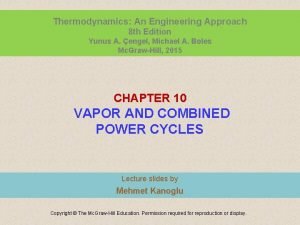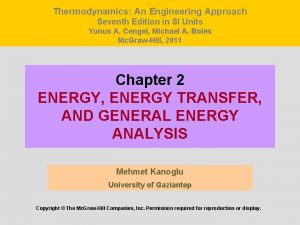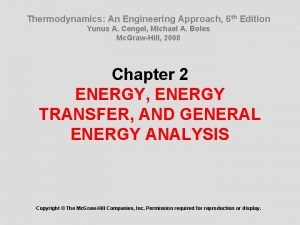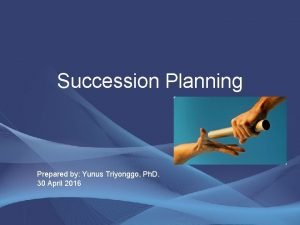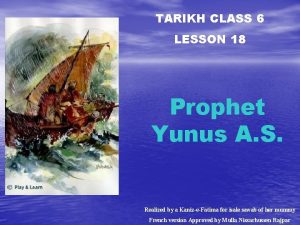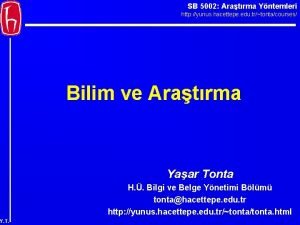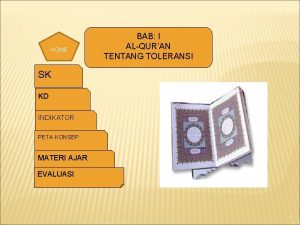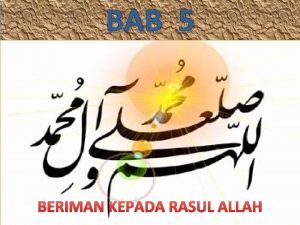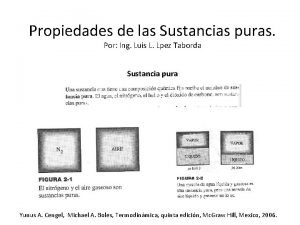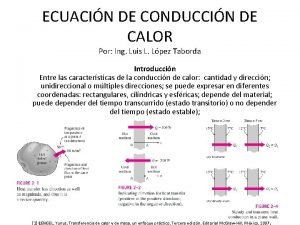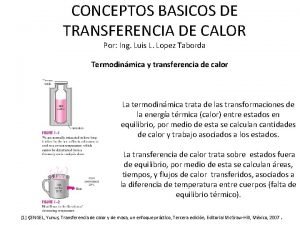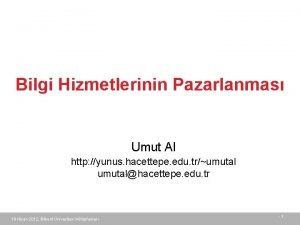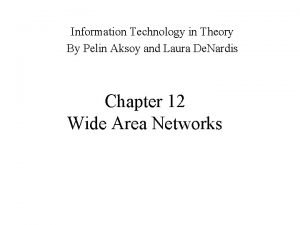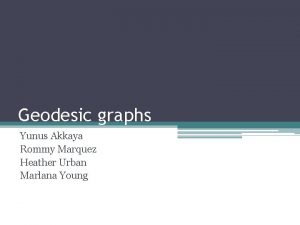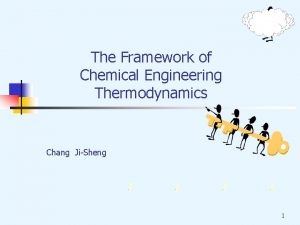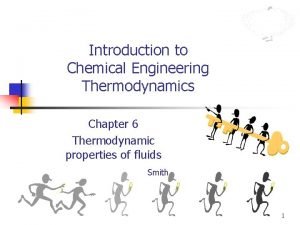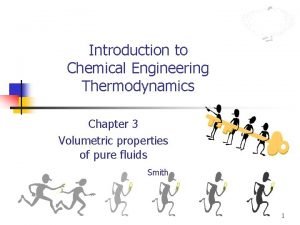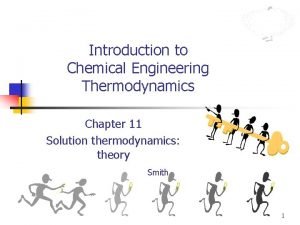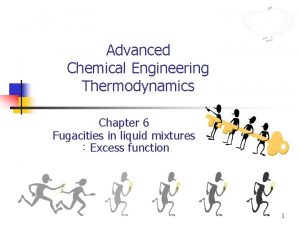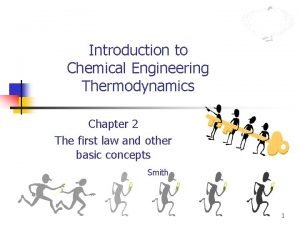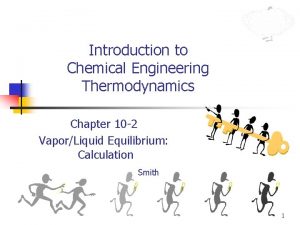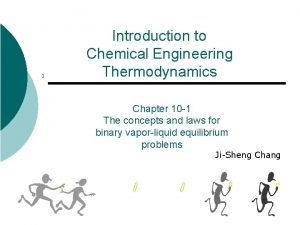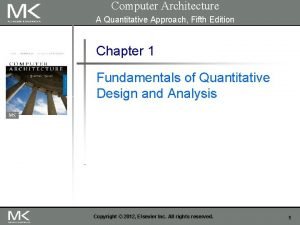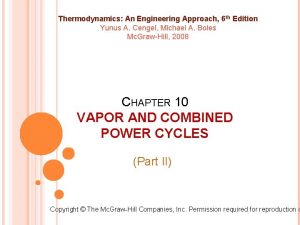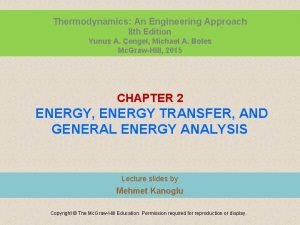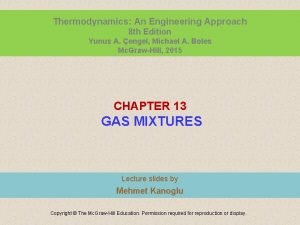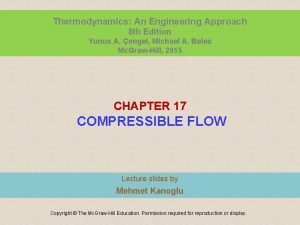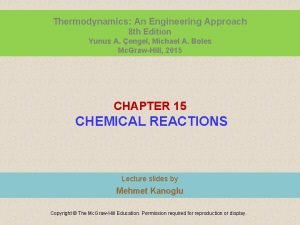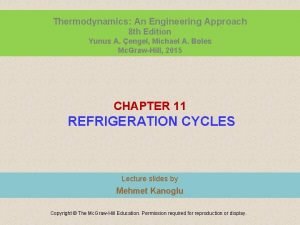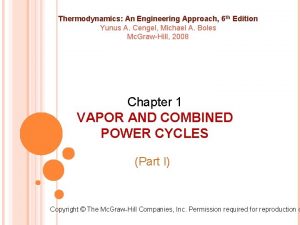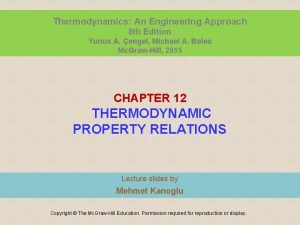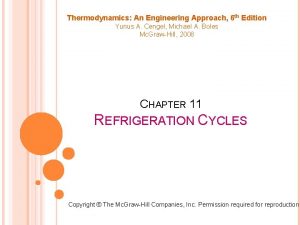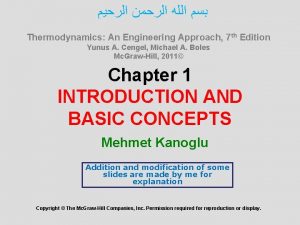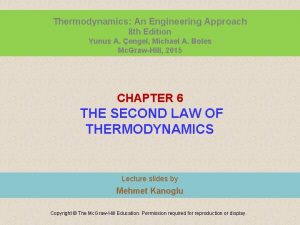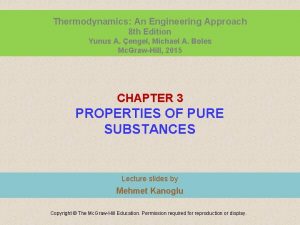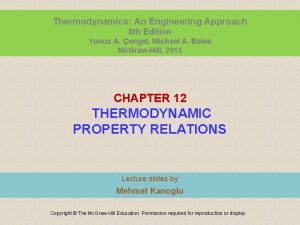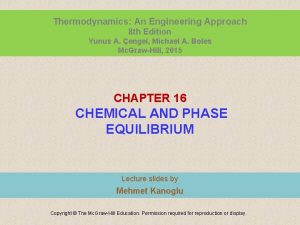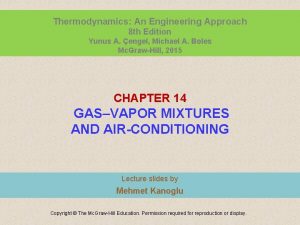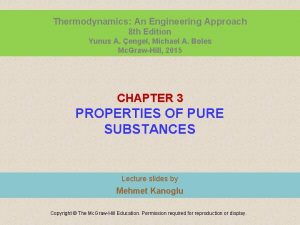Thermodynamics An Engineering Approach 8 th Edition Yunus





































- Slides: 37

Thermodynamics: An Engineering Approach 8 th Edition Yunus A. Çengel, Michael A. Boles Mc. Graw-Hill, 2015 CHAPTER 9 GAS POWER CYCLES Lecture slides by Mehmet Kanoglu Copyright © The Mc. Graw-Hill Education. Permission required for reproduction or display.

Objectives • Evaluate the performance of gas power cycles for which the working fluid remains a gas throughout the entire cycle. • Develop simplifying assumptions applicable to gas power cycles. • Review the operation of reciprocating engines. • Analyze both closed and open gas power cycles. • Solve problems based on the Otto, Diesel, Stirling, and Ericsson cycles. • Solve problems based on the Brayton cycle; the Brayton cycle with regeneration; and the Brayton cycle with intercooling, reheating, and regeneration. • Analyze jet-propulsion cycles. • Identify simplifying assumptions for second-law analysis of gas power cycles. • Perform second-law analysis of gas power cycles. 2

BASIC CONSIDERATIONS IN THE ANALYSIS OF POWER CYCLES Most power-producing devices operate on cycles. Ideal cycle: A cycle that resembles the actual cycle closely but is made up totally of internally reversible processes is called an. Reversible cycles such as Carnot cycle have the highest thermal efficiency of all heat engines operating between the same temperature levels. Unlike ideal cycles, they are totally reversible, and unsuitable as a realistic model. Thermal efficiency of heat engines: 3

The ideal cycles are internally reversible, but, unlike the Carnot cycle, they are not necessarily externally reversible. Therefore, thermal efficiency of an ideal cycle, in general, is less than that of a totally reversible cycle operating between the same temperature limits. However, it is still considerably higher than thermal efficiency of an actual cycle because of the idealizations utilized. 4

The idealizations and simplifications in the analysis of power cycles: 1. The cycle does not involve any friction. Therefore, the working fluid does not experience any pressure drop as it flows in pipes or devices such as heat exchangers. 2. All expansion and compression processes take place in a quasi-equilibrium manner. 3. The pipes connecting the various components of a system are well insulated, and heat transfer through them is negligible. On a T-s diagram, the ratio of the area enclosed by the cyclic curve to the area under the heat-addition process curve represents thermal efficiency of the cycle. Any modification that increases the ratio of these two areas will also increase thermal efficiency of the cycle. 5

THE CARNOT CYCLE AND ITS VALUE IN ENGINEERING The Carnot cycle is composed of four totally reversible processes: isothermal heat addition, isentropic expansion, isothermal heat rejection, and isentropic compression. For both ideal and actual cycles: Thermal efficiency increases with an increase in the average temperature at which heat is supplied to the system or with a decrease in the average temperature at which heat is rejected from the system. A steady-flow Carnot engine. 6

Derivation of the Efficiency of the Carnot Cycle 7

AIR-STANDARD ASSUMPTIONS Air-standard assumptions: 1. The working fluid is air, which continuously circulates in a closed loop and always behaves as an ideal gas. 2. All the processes that make up the cycle are internally reversible. 3. The combustion process is replaced by a heat-addition process from an external source. 4. The exhaust process is replaced by a heat-rejection process that restores the working fluid to its initial state. Cold-air-standard assumptions: When the working fluid is considered to be air with constant specific heats at room temperature (25°C). Air-standard cycle: A cycle for which the air-standard assumptions are applicable. 8

AN OVERVIEW OF RECIPROCATING ENGINES Compression ratio • • Spark-ignition (SI) engines Compression-ignition (CI) engines 9

Mean effective pressure The mean effective pressure can be used as a parameter to compare the performances of reciprocating engines of equal size. The engine with a larger value of MEP delivers more net work per cycle and thus performs better. 10

OTTO CYCLE: THE IDEAL CYCLE FOR SPARK-IGNITION ENGINES 11

Four-stroke cycle 1 cycle = 4 stroke = 2 revolution Two-stroke cycle 1 cycle = 2 stroke = 1 revolution The two-stroke engines are generally less efficient than their four-stroke counterparts but they are relatively simple and inexpensive, and they have high power-to-weight and power-to-volume ratios. Schematic of a two-stroke reciprocating engine. 12

13

Air enters the cylinder through the open intake valve at atmospheric pressure P 0 during process 0 -1 as the piston moves from TDC to BDC. The intake valve is closed at state 1 and air is compressed isentropically to state 2. Heat is transferred at constant volume (process 2 -3); it is expanded isentropically to state 4; and heat is rejected at constant volume (process 4 -1). Air is expelled through the open exhaust valve (process 1 -0). Work interactions during intake and exhaust cancel each other, and thus inclusion of the intake and exhaust processes has no effect on the net work output from the cycle. However, when calculating power output from the cycle during an ideal Otto cycle analysis, we must consider the fact that the ideal Otto cycle has four strokes just like actual fourstroke spark-ignition engine. 14

In SI engines, the compression ratio is limited by autoignition or engine knock. 15

DIESEL CYCLE: THE IDEAL CYCLE FOR COMPRESSION-IGNITION ENGINES In diesel engines, only air is compressed during the compression stroke, eliminating the possibility of autoignition (engine knock). Therefore, diesel engines can be designed to operate at much higher compression ratios than SI engines, typically between 12 and 24. 1 -2 isentropic compression 2 -3 constantvolume heat addition 3 -4 isentropic expansion 4 -1 constantvolume heat rejection. 16

Cutoff ratio for the same compression ratio Thermal efficiency of the ideal Diesel cycle as a function of compression and cutoff ratios (k=1. 4). 17

Dual cycle: A more realistic ideal cycle model for modern, high-speed compression ignition engine. In modern high-speed compression ignition engines, fuel is injected into the combustion chamber much sooner compared to the early diesel engines. Fuel starts to ignite late in the compression stroke, and consequently part of the combustion occurs almost at constant volume. Fuel injection continues until the piston reaches the top dead center, and combustion of the fuel keeps the pressure high well into the expansion stroke. Thus, the entire combustion process can better be modeled as the combination of constant-volume and constant-pressure processes. 18

STIRLING AND ERICSSON CYCLES Stirling cycle 1 -2 T = constant expansion (heat addition from the external source) 2 -3 v = constant regeneration (internal heat transfer from the working fluid to the regenerator) 3 -4 T = constant compression (heat rejection to the external sink) 4 -1 v = constant regeneration (internal heat transfer from the regenerator back to the working fluid) 19

T-s and P-v diagrams of Carnot, Stirling, and Ericsson cycles. 20

The Stirling and Ericsson cycles give a message: Regeneration can increase efficiency. Both the Stirling and Ericsson cycles are totally reversible, as is the Carnot cycle, and thus: The Ericsson cycle is very much like the Stirling cycle, except that the two constantvolume processes are replaced by two constant-pressure processes. 21

BRAYTON CYCLE: THE IDEAL CYCLE FOR GAS-TURBINE ENGINES The combustion process is replaced by a constant-pressure heat-addition process from an external source, and the exhaust process is replaced by a constant-pressure heat-rejection process to the ambient air. 1 -2 Isentropic compression (in a compressor) 2 -3 Constant-pressure heat addition 3 -4 Isentropic expansion (in a turbine) 4 -1 Constant-pressure heat rejection 22

Pressure ratio 23

The two major application areas of gasturbine engines are aircraft propulsion and electric power generation. The highest temperature in the cycle is limited by the maximum temperature that the turbine blades can withstand. This also limits the pressure ratios that can be used in the cycle. The air in gas turbines supplies the necessary oxidant for the combustion of the fuel, and it serves as a coolant to keep the temperature of various components within safe limits. An air–fuel ratio of 50 or above is not uncommon. 24

Development of Gas Turbines 1. Increasing the turbine inlet (or firing) temperatures 2. Increasing the efficiencies of turbomachinery components (turbines, compressors): 3. Adding modifications to the basic cycle (intercooling, regeneration or recuperation, and reheating). Deviation of Actual Gas-Turbine Cycles from Idealized Ones Reasons: Irreversibilities in turbine and compressors, pressure drops, heat losses Isentropic efficiencies of the compressor and turbine 25

THE BRAYTON CYCLE WITH REGENERATION In gas-turbine engines, the temperature of the exhaust gas leaving the turbine is often considerably higher than the temperature of the air leaving the compressor. Therefore, the high-pressure air leaving the compressor can be heated by the hot exhaust gases in a counter-flow heat exchanger (a regenerator or a recuperator). The thermal efficiency of the Brayton cycle increases as a result of regeneration since less fuel is used for the same work output. A gas-turbine engine with regenerator. 26

Effectiveness of regenerator Effectiveness under coldair standard assumptions Under cold-air standard assumptions The thermal efficiency depends on the ratio of the minimum to maximum temperatures as well as the pressure ratio. Regeneration is most effective at lower pressure ratios and low minimum-tomaximum temperature ratios. Can regeneration be used at high pressure ratios? 27

THE BRAYTON CYCLE WITH INTERCOOLING, REHEATING, AND REGENERATION For minimizing work input to compressor and maximizing work output from turbine: T-s diagram of an ideal gas-turbine cycle with intercooling, reheating, and regeneration. 28

Multistage compression with intercooling: The work required to compress a gas between two specified pressures can be decreased by carrying out the compression process in stages and cooling the gas in between. This keeps the specific volume as low as possible. Multistage expansion with reheating keeps the specific volume of the working fluid as high as possible during an expansion process, thus maximizing work output. Intercooling and reheating always decreases thermal efficiency unless they are accompanied by regeneration. Why? 29

IDEAL JET-PROPULSION CYCLES Gas-turbine engines are widely used to power aircraft because they are light and compact and have a high power-to-weight ratio. Aircraft gas turbines operate on an open cycle called a jet-propulsion cycle. The ideal jet-propulsion cycle differs from the simple ideal Brayton cycle in that the gases are not expanded to the ambient pressure in the turbine. Instead, they are expanded to a pressure such that the power produced by the turbine is just sufficient to drive the compressor and the auxiliary equipment. The net work output of a jet-propulsion cycle is zero. The gases that exit the turbine at a relatively high pressure are subsequently accelerated in a nozzle to provide thrust to propel the aircraft. Aircraft are propelled by accelerating a fluid in the opposite direction to motion. This is accomplished by either slightly accelerating a large mass of fluid (propeller-driven engine) or greatly accelerating a small mass of fluid (jet or turbojet engine) or both (turboprop engine). 30

Thrust (propulsive force) Propulsive efficiency Propulsive power 31

32

Modifications to Turbojet Engines The first airplanes built were all propeller-driven, with propellers powered by engines essentially identical to automobile engines. Both propeller-driven engines and jet-propulsion-driven engines have their own strengths and limitations, and several attempts have been made to combine the desirable characteristics of both in one engine. Two such modifications are the propjet engine and the turbofan engine. The most widely used engine in aircraft propulsion is the turbofan (or fanjet) engine wherein a large fan driven by the turbine forces a considerable amount of air through a duct (cowl) surrounding the engine. 33

34

Various engine types: Turbofan, Propjet, Ramjet, Sacramjet, Rocket 35

SECOND-LAW ANALYSIS OF GAS POWER CYCLES Exergy destruction for a closed system For a steadyflow system Steady-flow, one-inlet, one-exit Exergy destruction of a cycle For a cycle with heat transfer only with a source and a sink Closed system exergy Stream exergy A second-law analysis of these cycles reveals where the largest irreversibilities occur and where to start improvements. 36

Summary • • • Basic considerations in the analysis of power cycles The Carnot cycle and its value in engineering Air-standard sssumptions An overview of reciprocating engines Otto cycle: The ideal cycle for spark-ignition engines Diesel cycle: The ideal cycle for compression-ignition engines Stirling and Ericsson cycles Brayton cycle: The ideal cycle for gas-turbine engines The Brayton cycle with regeneration The Brayton cycle with intercooling, reheating, and regeneration Ideal jet-propulsion cycles Second-law analysis of gas power cycles 37
 Feedwater
Feedwater Thermodynamics an engineering approach
Thermodynamics an engineering approach Thermodynamics an engineering approach
Thermodynamics an engineering approach Yunus emrenin hayatı slayt
Yunus emrenin hayatı slayt Yunus triyonggo
Yunus triyonggo Hazrat yunus
Hazrat yunus Dr kamran yunus
Dr kamran yunus Gazel örnekleri
Gazel örnekleri Why was prophet yunus punished
Why was prophet yunus punished Yunus.hacettepe
Yunus.hacettepe Al yunus ayat 40-41
Al yunus ayat 40-41 Mukhlis yunus
Mukhlis yunus Peta konsep tentang iman
Peta konsep tentang iman Yunus a. cengel
Yunus a. cengel Surah yunus for diabetes
Surah yunus for diabetes Transferencia de calor yunus cengel
Transferencia de calor yunus cengel Yunus cengel
Yunus cengel Yunus.hacettepe
Yunus.hacettepe Yunus emre sarı
Yunus emre sarı Yunus programlama dili
Yunus programlama dili Yunus aksoy
Yunus aksoy Yunus akkaya
Yunus akkaya Engineering thermodynamics
Engineering thermodynamics Chemical engineering thermodynamics 8th solution chapter 6
Chemical engineering thermodynamics 8th solution chapter 6 Chemical engineering thermodynamics 8th solution chapter 3
Chemical engineering thermodynamics 8th solution chapter 3 Chemical engineering thermodynamics 8th solution chapter 4
Chemical engineering thermodynamics 8th solution chapter 4 Chemical engineering thermodynamics 8th solution chapter 6
Chemical engineering thermodynamics 8th solution chapter 6 Chemical engineering thermodynamics 8th solution chapter 2
Chemical engineering thermodynamics 8th solution chapter 2 Chemical engineering thermodynamics 8th solution chapter 10
Chemical engineering thermodynamics 8th solution chapter 10 Duhem theorem
Duhem theorem Using mis 10th edition
Using mis 10th edition Using mis (10th edition) 10th edition
Using mis (10th edition) 10th edition Computer architecture a quantitative approach 5th edition
Computer architecture a quantitative approach 5th edition Computer architecture a quantitative approach sixth edition
Computer architecture a quantitative approach sixth edition Child development: an active learning approach 4th edition
Child development: an active learning approach 4th edition Computer architecture a quantitative approach 6th
Computer architecture a quantitative approach 6th Democritus atomic model diagram
Democritus atomic model diagram Computer architecture a quantitative approach sixth edition
Computer architecture a quantitative approach sixth edition
